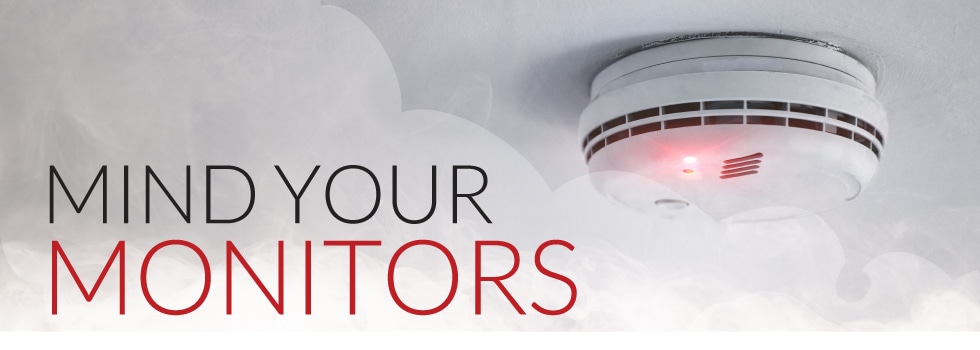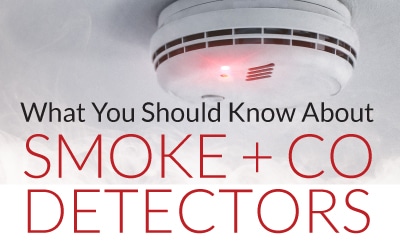
What you should know about smoke and CO detectors
On Nov. 7, everyone will “fall back” an hour to mark the end of Daylight Saving Time. This is the period when the International Fire Chiefs Association suggests that homeowners check or replace their smoke and carbon monoxide (CO) detector batteries.
But maybe you need to do more than check batteries. For instance, when was the last time you replaced your detectors? Is it time to upgrade to new, higher-performing monitors to safeguard your home and loved ones?
Smoke alarms were credited with providing
an early alert in 74 percent of residential fires.
Truth is, most of us ignore our detectors until they begin emitting annoying chirps or beeps. It’s easy to forget how important they are in protecting us. In a 2021 National Fire Protection Association (NFPA) report, smoke alarms were credited with providing an early alert in 74 percent of residential fires reported to fire departments in the U.S. In cases where people died in house fires, three out of five were in homes with no smoke alarms or ones that failed to operate.
CO detectors are just as important, especially in homes using natural gas-fueled water heaters, furnaces, stoves and fireplaces. The National Center for Environmental Health reports that at least 430 people die each year in the U.S. from colorless, odorless carbon monoxide gas. Approximately 50,000 Americans visit the emergency department each year due to accidental CO poisoning.
Before you make your semi-annual trek around the house to visit your detectors, here are seven things you should know to keep these important monitors in good working order.
-
- They don’t last forever. A smoke alarm self-tests for smoke every 40 to 60 seconds as it constantly monitors the air 24 hours a day. During a 10-year lifespan, the electronics in a smoke detector have carried out more than 7.8 million tests. After so much use, the detector sensors may become less reliable and the potential for failure increases. Replace your smoke detector every 10 years for optimum performance and safety.
CO detectors have a lifespan of about 5 to 7 years.
CO detectors have a shorter lifespan — about 5 to 7 years. Look for an expiration date on the label. If there’s no date on yours, you’re probably due for a new CO monitor.
If you’ve purchased a home recently and aren’t sure when the current alarms were replaced or installed, it’s best to upgrade them right away.
- Sensor type matters. All detectors are not created equal, so be careful what you choose. A dual sensor smoke detector is best for identifying a fire emergency quickly. This type of monitor has an ionization sensor that will register a “fast flame” fire — caused by an accelerant, such as gasoline, cooking oils, grease or paper. It also has a photoelectric sensor to detect a smoldering fire before open flames develop.
Opt for a CO detector with electrochemical sensing technology.
For CO detection, opt for a model with electrochemical sensing technology. This sensor is more sensitive to CO and less prone to false alarms. There are other types of sensors on the market (metal oxide and gel cell) that offer longer life. But humidity and temperature changes can reduce their accuracy.
- More is better. The NFPA recommends installing smoke detectors on every floor of your home (including the basement), in each bedroom, outside of sleeping areas and in hallways.
Install detectors on every level of your home.
CO detectors should be placed throughout your home, too. Put one in your kitchen, in bedrooms, in a room with a fireplace and anywhere you have a fuel-fired appliance, like the area where your heating system is kept. If you live in a multi-story home, there should be a CO detector on each level. If you park your car in your garage, consider placing one there, too.
- Location is critical. There should be no more than 30 feet of distance between each smoke detector, says the NFPA. Since heat and smoke rise, smoke detectors should always be installed on the ceiling. Remember: Installing smoke detectors near doors, air vents and windows will decrease the chances that they will work properly.
Smoke detectors should always be installed on the ceiling.
Rather than rising like smoke, carbon monoxide mixes with the air. Because of this, some safety experts recommend installing CO detectors at around knee height. Manufacturers generally suggest locating digital-display wall-mounted detectors at eye level so you can easily view CO levels. Wall-mounted CO detectors should never be placed any higher than 15 inches below the ceiling.
- Invest in interconnection. With an interconnectivity feature, all units in the house will sound an alarm when any single one is triggered. Interconnected detectors are especially recommended for multi-level homes because they can alert you to danger before a fire or CO spreads. Tip: Some detectors with the interconnectivity feature will only work with like models. Before purchasing or installing, check the manufacturer to be sure your detectors are compatible.
Dust can prevent your detectors from properly sensing
a buildup of smoke or dangerous carbon monoxide.
- Make maintenance a priority. In addition to being the cause of many false alarms, dust can prevent your detectors from properly sensing a buildup of smoke or dangerous carbon monoxide. Wipe off and clean the unit with a dry cloth to remove dust and grease. Twice a year, vacuum away dust and cobwebs from around and inside detectors. Never use water or cleaners on the units. Also, never paint over any detector. Test detector function once a month.
EMC Security offers affordable, professional monitoring
of smoke and CO detectors.
- Professional monitoring is safer. Tying your smoke/CO detectors into a professionally monitored home security system provides next-level safety. This will ensure that your detectors do more than simply make a noise if trouble is sensed; they’ll get help, even if you’re not home. Walton Gas affiliate EMC Security offers affordable monitoring service.
You can rest easy when you mind your monitors. Properly selecting, installing, monitoring and maintaining smoke and CO detectors means you’re prepared in the event of an emergency.
